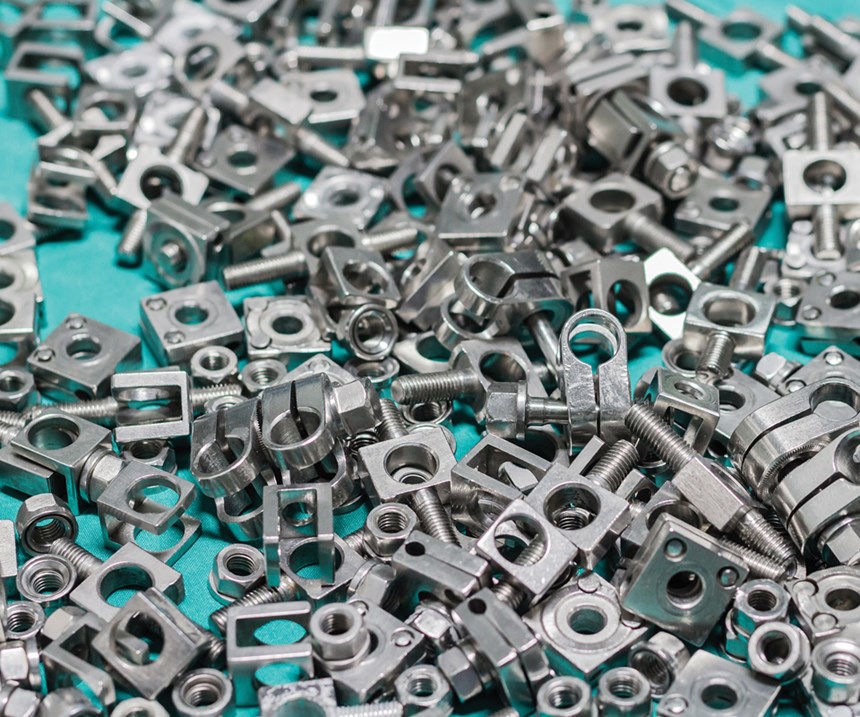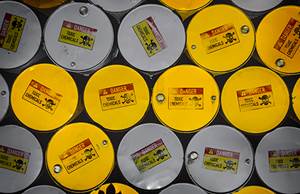Vacuum Degreasing Offers Lean and Green Technology
One common cleaning system will work on all production parts without having to operate and maintain separate systems.
A lot of OEMs encounter issues with new lubricants or machine coolants that do not react with existing cleaning processes. New synthetic lubricants will not clean in the same process or system as organic-based lubes. High temperature lubes often require more mechanical action and sometimes even a different cleaning chemistry. Various grade metals react with forming, machining processes or dies, and most metals often require corrosion protection. These modifications in parts cleaning are generally affected by the ever-tightening environmental regulations including restrictions on air emissions, waste discharge/disposal and personal safety.
Vacuum degreasing technology is now being applied to small parts/high volume production methods to yield superior cleaning, environmentally preferred features, various processing options and lower total cost of ownership. The process is leading the way to replace old solvent cleaning systems as well as some alternate aqueous cleaning processes.
New vacuum degreasing equipment is designed to offer a variety of cleaning applications in one central piece of equipment using one chemical cleaning agent for all soils and processes.
The ‘All in One’ Cleaning Machine
Most new vacuum degreasers offer many process options inclusive in one machine, which helps with shortening the overall process time. The end user simply selects the cycle program and functions that match the needs of the parts being processed. The human machine interface controls everything from desired wash stages to dwell times to the type of mechanical action required.
Small parts in high-volume applications generally require immersion cleaning to ensure all part surfaces are exposed to the cleaning agent. Soils to be removed include cutting oil or lube (non-polar in nature) or water-soluble coolants (typically polar in nature). Most bulk parts in common work baskets require mechanical action to enhance the soil removal, such as rotation or basket rocking action, ultrasonic, bath turbulation (spray under immersion) and multiple stages of washing (hydraulic flooding effect).
These mechanical actions combined with the cleaning agent’s chemical compatibility and operational temperature create the process required to remove the soils in a desired timeframe and provide the cleanliness level to meet a shop’s production requirements. The process can reach the center of the work basket where parts are shielded from external impingement actions.
Acceptable cleaning of all parts must ensure that required cleaning levels are met before the next process step, whether that is plating, coating, heat treating, additional machining or packaging for release to buyer.
Production Flexibility
For decades, solvent degreasing was the preferred cleaning method for most high volume/small parts manufacturers. Compared with aqueous cleaning, most factories found degreasing to be a simple, one-step process, requiring less floor space, maintenance and cost, while providing better compatibility for numerous soils and substrates.
Government regulatory changes created a partial exit from solvent cleaning and resulted in an increase in aqueous processes. We are now seeing a change back to vacuum solvent processes.
Degreasing is especially effective for parts with complex geometries because of solvents’ ability to penetrate the smallest tolerances. These parts are sometimes difficult to rinse and dry in a required timeframe. Solvent usage in a vacuum degreaser improves that portion of the cleaning process. If any solvent remains on the part, it will be evaporated inside a sealed chamber, leaving minimal or no residue without affecting the substrate, and most important, not being discharged into the atmosphere.
When used with the correct chemistry, these units will work equally well with removing both polar and non-polar soils. This means one common cleaning system will work on all production parts without having to operate and maintain separate systems.
For parts requiring an anti-corrosion protection, the process can be easily adapted to include rust preventive application inside the system, eliminating the need for a separate application device and material handling equipment.
These systems reduce energy consumption over typical degreasers or aqueous process lines because of vacuum technology that allows the solvent to operate at a lower temperature. Because of the enclosed design, solvent consumption is considerably lower on an annual purchasing basis by as much as 50 percent or more. The floor space requirement is generally less than most tank lines.
Most of these units have an internal separation system that removes the soils from the solvent. This allows the same solvent to be reused for conservation of operational cost as well as reduction of waste disposal volume.
Environmental Health and Safety Features
During the vacuum degreasing cleaning process, all cleaning work is conducted inside a sealed unit, isolating any operator from potential chemistry contamination as well as reducing any fugitive emissions such as VOCs that could contribute to global warming. Ambient area personnel are not exposed to an open process tank subject to fugitive emissions migration created by wind drafts or improper system operation and lack of proper ventilation.
Dirty metal parts enter the system, and clean parts exit only after all the proper cycles have been completed. The process chamber door is sealed before the cleaning cycle starts and only opened after the process chamber has been evacuated of residual cleaning solvent.
Clean and dry parts can be removed and generally are immediately ready for the next stage because lower part temperature allows rapid handling.
During processing, there isn’t remaining chemistry to drain. Waste is separated for periodic disposal, but at a lower volume compared with discharging the entire tank bath, as was done in the past.
There is also no rinse water to recycle or dispose of. This feature is a strong point in the Clean Water Act compliance.
Chemical Compatibility
Modified alcohol is the typical cleaning agent used in most new degreasers. Chemistries such as Kyzen’s Metalnox M6386 cleaning blend are designed to clean a range of oils and coolants as well as metal fines, and are safe on steel, brass, aluminum and other metals. Europe has led the way for this type of process to replace both solvent and aqueous systems in recent years.
The modified alcohol solvents feature compatibility with a variety of metals, removal of both polar and non-polar soils, excellent solvency for a range of soils, low surface tension to penetrate and remove soils from blind holes and crevices and low odor on parts upon exiting the system. Other benefits include dry parts and those free of chemical residue, parts that can be recycled or reused, parts that meet regulatory and safety requirements, and these solvents are not listed as a hazardous air pollutant by the EPA.
Hydrocarbon compound such as Kyzen Metalnox M6381 is another common solvent used in vacuum degreasing. This solvent is usually not recommended for polar soils. The process using hydrocarbons requires higher operational temperature than modified alcohols. Hydrocarbon chemistry and its process is quickly growing worldwide, especially in the U.S. where small parts in large volumes create the need to clean and dry quickly and thoroughly inside a work basket filled with small parts.
The benefits of modified alcohol and hydrocarbon compound solvents to match the new equipment process have led to the acceptance of these solvents by many users—those who cannot or will not use a water cleaning process, and those who require solvent cleaning for blind holes, cavities and passageways where the substrate requires cleaning, rinsing and drying. Sometimes water processes simply will not work.
Why Switch to Vacuum Degreasing?
Small metal parts, especially in high volume bulk, are sometimes difficult to clean and dry in the desired timeframe. They can present material handling issues to prevent part damage during transfer from containers to the cleaning process or during the cleaning process itself.
Various substrate materials or soils may require dedicated process equipment and/or application-specific chemistry. In addition, environmental health and safety concerns are front and center in any plant; the Occupational Health and Safety Administration, Environmental Protection Agency, American Conference of Governmental Industrial Hygienists and other organizations are developing new guidelines that may affect current process methods. Cost of quality increases as a result of rejects/rework; overall operational costs for chemicals, utilities, labor, waste disposal; operational compliance and monitoring/process adjustments and other items.
Environmental impact is driving equipment design toward enclosed systems when possible. Whether in an atmospheric shielded tank or hermetically sealed chamber, vacuum degreasing is easily becoming the preferred process of many companies. Lower solvent usage costs and emissive losses, combined with a controlled process that yields repeatable results with minimum operator interface are the advantages of these systems.
Vacuum Degreasing’s Future
Vacuum degreasers are quickly becoming the future of solvent cleaning technologies for small parts/high volume cleaning, and they generally function equally well with most aqueous soils.
In this market, the industry is seeing new machines being ordered at an increasing rate for many different reasons. Small precision cleaning operations are demanding totally enclosed systems featuring automation that will minimize operator interface while conserving as much solvent as possible.
The adage that solvent cleans better, faster and in more restrictive places than water is still true. And now many safe solvents are available.
The fact that today’s cleanliness specifications for precision and critical cleaning cannot have any contaminant residue or rinse water residue on the end product still drives some users toward solvent.
The cost to clean will always be a part of this equation as will the cost for environmental compliance and end user confidence. There isn’t a “one size fits all” solution. Some applications can use either solvent or aqueous, and there will remain alternate choices for all.
Solvent and equipment manufacturers believe this new vacuum degreasing process will remain viable for many years. We know the equipment will evolve as well as the solvent that goes into it, but the basic process will remain similar. The improvements will come in new solvent blends and processes, material handling concepts, solvent recovery systems and even tighter environmental compliance.
For more information from Kyzen Corp. about vacuum degreasing, visit kyzen.com.
Related Content
Parts Cleaning Sector Shifts Energy Toward Regulatory Changes
With changes in EPA regulations regarding the use of some popular cleaning fluids, cleaning suppliers and end users are readjusting business strategies and/or cleaning processes to meet new requirements.
Read MoreSita’s CleanoSpector Measures Part Cleanliness
PMTS 2023: Handheld measuring device checks for cleanliness of parts to assure product quality as well as prior to follow-up processes.
Read MoreA ‘Clean’ Agenda Offers Unique Presentations in Chicago
The 2024 Parts Cleaning Conference, co-located with the International Manufacturing Technology Show, includes presentations by several speakers who are new to the conference and topics that have not been covered in past editions of this event.
Read MoreMeeting Stringent Cleaning Goals With Modular Ultrasonic System
A knee implant manufacturer implements an advanced cleaning system that meets its tight cleaning requirements, including documenting, validating and tracing the entire cleaning process.
Read MoreRead Next
The Right Solvent Creates the Cleanest Parts
Cox Manufacturing Co. has worked with Kyzen Corp. since it implemented its vacuum vapor degreaser to find just the right chemical solvent to clean its customers’ parts to their specifications and beyond.
Read MoreA Tooling Workshop Worth a Visit
Marubeni Citizen-Cincom’s tooling and accessory workshop offers a chance to learn more about ancillary devices that can boost machining efficiency and capability.
Read MoreDo You Have Single Points of Failure?
Plans need to be in place before a catastrophic event occurs.
Read More























